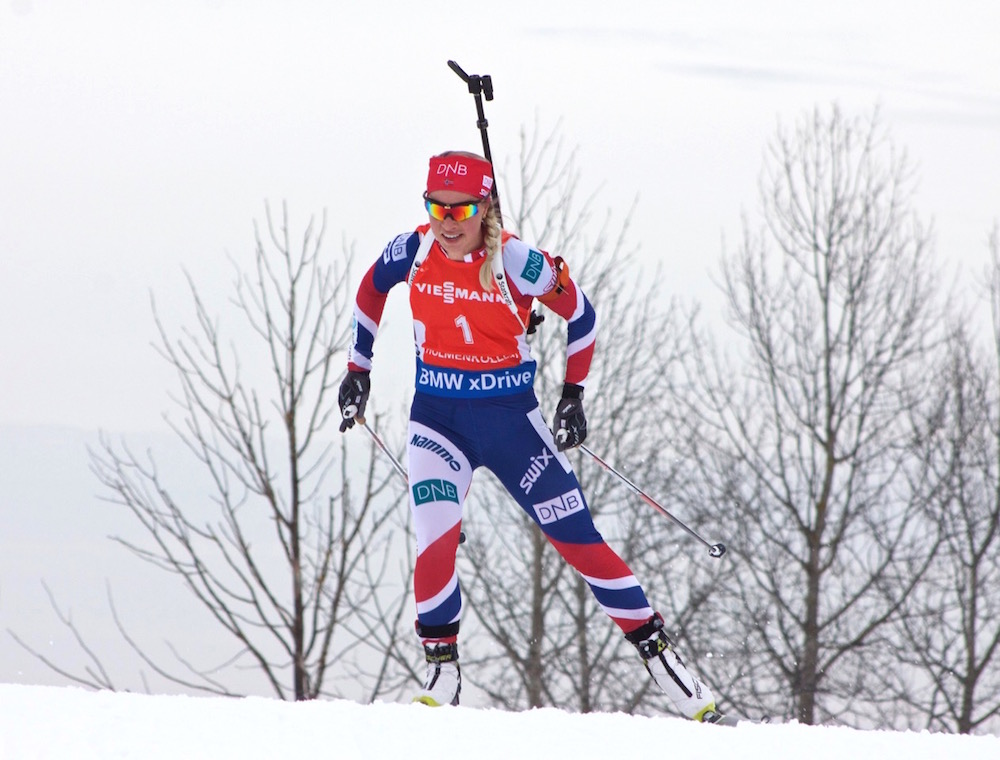
Lars Helge Birkeland, Johannes Thingnes Bø, Tarjei Bø, and Erlend Bjøntegaard. (Photo: IBU/NordicFocus)
The Norwegian biathlon team is coming off of a high note last season, when they hosted World Championships in Oslo and saw gold-medal performances from Tiril Eckhoff, Johannes Thingnes Bø and both its men’s and women’s relay teams. The legendary Ole Einar Bjørndalen also picked up an individual silver medal to add to his collection.
The team’s task now is about keeping up the intensity and building towards the 2018 Olympics in PyeongChang, South Korea. One target metric: to have both its men’s and women’s teams ranked in the top two at the end of the year.
Last season, the Norwegian men won the Nations Cup and its women ranked seventh.
“This will probably, to some degree, become a sort of ‘in-between’ season,” Norwegian Biathlon Association President Erlend Slokvik recently told FasterSkier on the phone. “But athletes that didn’t perform as well as they had wanted will probably be extra motivated to do well this season. There was also a bigger focus on peaking in the World Championship [last season], because being part of one in your home country is sort of like an Olympics.”

Slokvik was elected president in May after having served as first vice president for the last eight years. He coached the Norwegian biathlon teams from the spring of 2000 to the spring of 2002, during which time the Norwegians won eight medals at World Championships and six medals at the Olympic Games in Salt Lake City, Utah.
After his election, Slokvik emphasized that having the world’s best biathlon team was important in order to attract sponsors, continue good recruiting and development of top-level athletes. He wanted to focus especially on coaches’ education and the development of new biathlon arenas to help towards this goal.
While biathlon is already a very popular winter sport in Norway, the federation is also aiming to build from its grassroots and development levels after Oslo.
“We have noticed a greater interest to some degree, but biathlon has been a popular sport for a long time, one of the most popular in the country, so there is a limit to how much of an increase we can see,” Slokvik explained. “But there has definitely been an increase, which is something we see in, for example, ticket sales for World Cup events … There is good recruiting in many places and the World Championship definitely contributed to that. We did a recruiting tour in connection the championships, which Tora Berger among others were part of and this definitely had an effect on recruiting.”
While the usual suspects are expected to contribute to the national-team results this season, there are opportunities for newcomers, like Marte Olsbu, who had something of a breakthrough at the Oslo World Championships, finishing seventh in the mass start and turning in strong legs in the mixed and women’s relays.

“In the men’s team, we have the ‘big four’ (Emil Hegle Svendsen, Bjørndalen and Tarjei and Johannes Bø) whom we expect to do well, as for the rest of the team we’re hoping that more and more athletes will stabilize on such a high level,” Slokvik said. “In the women’s team we hope that Marte will stabilize on a level close to Tiril [Eckhoff]. She won the sprint and pursuit rollerski national championships, so she is in good shape.”
While the team did almost entirely dryland training through October, it is now transitioning to a new phase.
“A lot of it has been threshold training, and preparation for shooting with an elevated heart rate,” Slokvik said. “Because of that the athletes haven’t done as much high-altitude training and instead spent time in lower elevation. They are in Trysil [Eastern Norway] now training in good conditions. They’ve spent time in France, for example in October, normally they would have spent time [on the glacier] in Val Senales, where they ski in high altitudes, but not this year. This [lower altitude] has allowed for more specific biathlon training, such as skiing with higher heart rate and shooting.”
While the Norwegian biathlon has steered clear of the doping scandals that deeply impacted its cross-country counterparts this summer and fall, those events prompted the federation to review its policies towards medication for athletes.
“We’ve gone through our routines and been clear in our communication with athletes, who have become even more aware of what they should do and not do,” Slokvik said. “Basically we followed already established routines.”

It has caused some stress and worry: Eckhoff said in an interview with Aftenposten that she has stopped taking her asthma medication. But it’s not because doing so was breaking any rules, Slokvik said.
“Since the news of [Martin Johnsrud] Sundby’s situation and the team’s use of asthma medication, athletes even with a diagnosis have been suspected and she didn’t want to contribute any more to that,” he explained. “Tiril has a diagnosis, but the severity of [her asthma] at the present time isn’t at a level where she wouldn’t be able to function without the medication. If it had, she wouldn’t have stopped taking it.”
The first competitions of the biathlon season are approaching on Saturday in Sjusjøen, Norway. Is the host team primed for improved performances over last year?
If those goals of being one of the top two teams in the world are any indication, it’s likely.
“We feel that this is a realistic goal, and it was set based on past performances,” Slokvik said.




